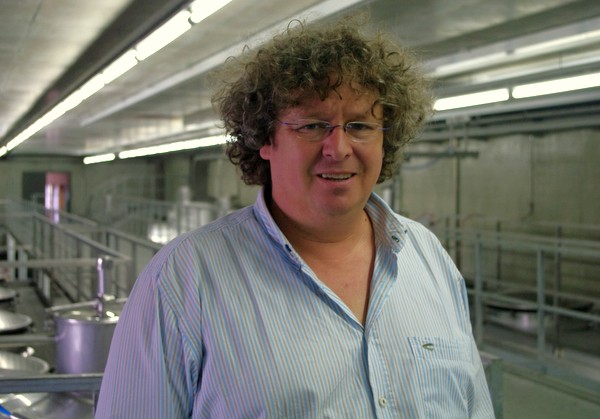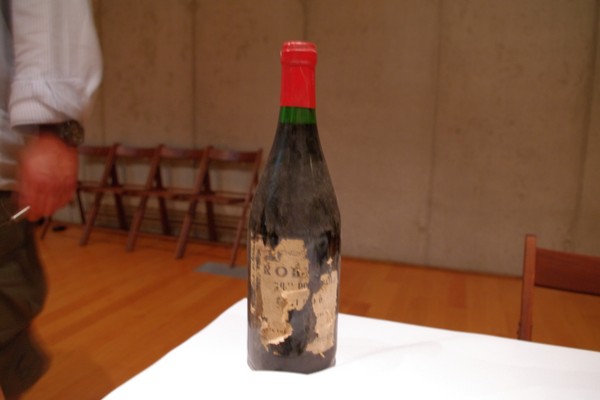|
The
Dirk Niepoort interview
Concerning Robustus 1990, the Douro table wine revolution and the
future for the region

Dirk Niepoort
On Saturday night (15 September 2012) I
had dinner with Dirk Niepoort at Quinta do Napoles in the Douro. It
was a lovely evening with a bunch of like-minded wine people and
some very nice wines. Particularly special was the bottle of
Robustus 1990 that Dirk opened: the wine that was the start of his
current work with table wines from the region. I’d tasted it once
before, but here was a chance to drink it with Dirk, and ask him
some questions about Robustus and the table wine revolution that has
taken place in the Douro over the last 20 years.

Jamie Goode (JG): So this is Robustus
1990 (above). Your first table wine?
Dirk Niepoort (DN): Sort of, yes. I made
little trials before but this was the first time I made a serious
quantity. It was the first time I tried seriously to do something,
believing in the potential of the Douro.
JG: Where did the grapes from?
DN: From Carril. This is when I first
started believing that north-facing vineyards make sense. It is a
vineyard that then was 60–70 years old, north facing, with mixed
planting. It was made under bad conditions. At the time I didn’t
have money. I designed some stainless steel tanks to avoid having
legs, to make them as cheap as possible. At the time, the idea was
extracting a lot. This is actually a wine that was quite extracted.
I recently thought about this. When I was in California someone
asked me if I would go back to Portugal and make wine. I said yes, I
will be making Port. Yes, but will you be making wine? I said yes,
probably, it makes sense. So what kind of wine will you be making? I
said that I think my first wine is going to be a monster, but 20
years down the road I think I will be making fine wine. This person
said, if you think you are going to be making fine wine, why don’t
you just make fine wine. I said, because I haven’t a clue what
fine wine is, I don’t understand it, and I surely don’t know how
to make a fine. It is interesting: this was a monster, but it has
turned out quite alright. This makes me think that with all this
talk we have that we want to make elegant harmonious wine, maybe
there are other ways of doing wine that result in good wine. This
wine was quite nasty when it was young. It was very tannic. I took
it as a barrel sample to a tasting, and everyone laughed at me and
said that the wine is uncommercial, undrinkable, unsellable and un-
eveything. We kept this for four years in old wood, and then the
good news is because no one liked it, I was afraid of showing it to
people, so I said to my cellarmaster we will bottle it and when my
son Daniel is 18 he can do whatever he wants with it. Actually, I
told this recently to a bunch of people and he was in the crowd. So
after the speech he came and said, ‘Dad, where is my wine?’ I
said, ‘what do you mean, “my wine”?’
‘You just said 1990 Robustus is my wine, I am over 18
now.’ ‘I just said it.’ ‘I have some witnesses: where are
the bottles?’ It is amazing. Every bottle is good. The wine seems
to be getting better and better with age.
JG: So the following vintage 1991 you
made your first Redoma.
DN: This was made in a similar way, but
much shorter ageing. But this is also showing very nicely.
JG: So you have a long history now of
making table wines in the Douro. It seems the whole scene has been a
revolution. It is an old region with these new wines.
DN: I like to say we have 2000 years of
making bad wine, except for the Port, of course. We have a long
history, but it looks to me that everyone was concentrating on the
Ports. By having one priority, you made the Port first, and then
made the table wines with the leftovers. This doesn’t work. You
really have to focus on two things at the same time. If necessary
you have to have two wineries. You need two teams, if necessary. I
am exaggerating. But you have to respect the vineyards and picking
times for each.
JG: Of the Douro boys, you are alone in
being equally serious about Port and table wines. Do you think the
two can coexist happily?
DN: I don’t even believe in it, I am
totally convinced that the future of the Douro has to go through
three priorities at the same time: the Port, the table wine (be it
white or red), and also the tourism. If we play the game well on the
three we can only win. Then, for the growers, the future is bright.
I think the first thing we have to stop is this fighting about
whether the wine is better or more important than the Port. On top
of that, for me there is no doubt that the best vineyards for Port
are clearly not as good for table wine. Port likes special
conditions. It likes exaggerated conditions: too much heat, dry
conditions. For great Ports the vineyards just stop the maturation
because it is too dry and hot, and then a little bit of humidity
makes the sugars go up and the acidity down. Acidity is my fetish
and the thing I believe most in, but for Port it is not as
important. For white and red wine, I have no doubt that the key
element is acidity, which is not something that we have in
abundance, so we have to find ways to keep this acidity. This is
where the Douro is special. It is 45 000 hectares. It is huge. It is
not like most vineyards where you have south/east/west expositions.
We have north, east, south, everythingf. It is not 100–200 m
height; here we are talking about 80–800 metres. And we are not
talking about one, two or three varieties—we are talking about 85
varieties. It is a complicated matter. But I will change the word
‘complicated’ to ‘complex’. We have to do what we have done
for Port: we have to understand which are the vineyards for Port,
which we know, and now we have to find out what we can do with the
rest of the vineyards and what is the true potential for making
great wine. Everyone laughs at me because I like these very high
vineyards. Yes, they are always greener than the other ones, but it
is a question of waiting, of patience. Because it is so hot,
sometimes it is important to pick the high vineyards a little bit
earlier, may be even a bit greener, and blend it. Therefore you
don’t have to make acid corrections and you have lightness and
elegance. The future is very bright. When I started making Robustus
it was a revolution and I was alone, more or less. Joăo
Nicolau de Almeida started about the same time, and Gaivosa did.
Slowly some others started. Then the second revolution came in
2000/2001, when suddenly there was a bunch of people really going
for it. Now it is easy and no one questions making wine in the Douro,
except for one Port house. It is probably the most famous area of
Portugal at the moment and it will probably grow in the future.
JG: As well as the red table wines, you
have been quite a pioneer of whites. Do you think these have an
important future in the Douro?
DN: It is obvious. When I started I was
the only one; now I have many colleagues making very good wines. 20
years ago no one really talked about white wines: we drank Vinho
Verde and not much more. Now white wines are a big thing. It is
totally linked to the quality of the wines. These have increased in
quality and there is a positive evolution. There is a lot to learn,
but the future is bright.
JG: So what was it that enabled this
table wine revolution to happen?
DN: I think globalization is a negative
thing, but it has a positive side. People are travelling a lot more.
Portugal was a really closed country, economically and politically
speaking. It was difficult to go out and come in. It was very poor.
The fact that people are travelling more and people see more through
the internet makes a huge difference. It is not technology. It is
also technology, but I think technology is becoming a problem.
Portugal is in a similar situation to South Africa. Both countries
went from making some great wines but mostly rustic, old fashioned,
oxidative wines, and they jumped from this extreme to the other,
which is making highly technological wines. I like to call these
castrated wines because they all taste the same; they are fruit
driven; they are made with all sorts of chemicals. This is bad.
Portugal needs to respect traditions more, and the local varieties.
We should be happy to be in Portugal because this is a hidden
treasure. We have old vines and all these varieties. We are probably
the richest country in the world in terms of varieties and terroir.
It is amazing how small Portugal is and how many different terroirs
we have. You can go 20 miles east, west, north or south and suddenly
you move from schist to granite to calcareous soils. You don’t
find this anywhere else. There is a new generation who have studied,
which is a good thing, but it tends to be a generation who only do
what they studied. There is something missing: the hearts; the love
for the wine. There is a great potential to grow in a positive way.
See
also:
 Dirk
Niepoort retrospective Dirk
Niepoort retrospective
Find these wines with wine-searcher.com
Back
to top
|

